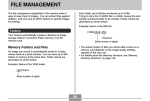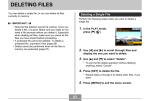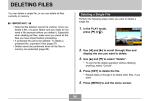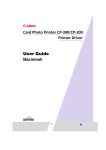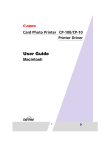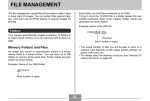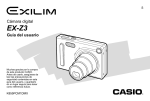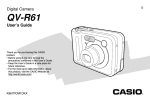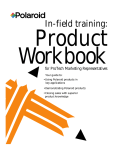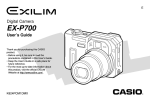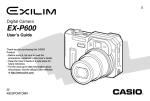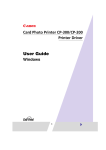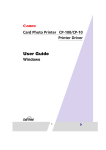Download EXS20U_M20U_4_na - Support
Transcript
FILE MANAGEMENT FILE MANAGEMENT Each folder can hold files numbered up to 9,999. Trying to store the 10,000th file in a folder causes the next serially numbered folder to be created. Folder names are generated as shown below. The file management capabilities of the camera make it easy to keep track of images. You can protect files against deletion, and even use its DPOF feature to specify images for printing. Example: Name of the 26th file Folders CIMG0026.JPG Your camera automatically creates a directory of image storage folders in its built-in Flash memory or on the memory card. Extension Serial number (4 digits) Memory Folders and Files • The actual number of files you will be able to store on a memory card depends on the image quality settings, capacity of the card, etc. • For details about the directory structure, see “Memory Directory Structure” on page 137. An image you record is automatically stored in a folder, whose name is a serial number. You can have up to 900 folders in memory at the same time. Folder names are generated as shown below. Example: Name of the 100th folder. 100CASIO Serial number (3 digits) 95 FILE MANAGEMENT 4. Use [] and [] to Protecting Files select “On”, and then press [SET]. Once you protect a file it cannot be deleted (page 93). You can protect files individually or you can protect all files in memory with a single operation. • A file that is protected is indicated by the mark. To protect a single file • To unprotect a file, select “Off” in step 4, and then press [SET]. 1. In the PLAY mode, press [MENU]. 5. Press [MENU] to exit the menu screen. 2. Select the “PLAY” tab, select “Protect”, and then press []. 3. Use [] and [] to scroll through files and display the one you want to protect. 96 FILE MANAGEMENT To protect all files in memory DPOF The letters “DPOF” stand for “Digital Print Order Format”, which is a format for recording on a memory card or other medium which digital camera images should be printed and how many copies of the image should be printed. Then you can print on a DPOF-compatible printer or at a professional print service in accordance with the file name and number of copies settings recorded on the card. With this camera, you should always select images by viewing them on the monitor screen. Do not specify images by file name without viewing the file contents. 1. In the PLAY mode, press [MENU]. 2. Select the “PLAY” tab, select “Protect”, and then press []. 3. Use [] and [] to select “All Files : On”, and then press [SET]. • To unprotect all files, press [SET] in step 3 so the setting shows “All Files : Off”. 4. Press [MENU] to exit the menu screen. ■ DPOF Settings File Name, number of copies, date 97 FILE MANAGEMENT 5. Use [] and [] to specify the number of To configure print settings for a single image copies. • You can specify up to 99 for the number of copies. Specify 00 if you do not want to have the image printed. 1. In the PLAY mode, press [MENU]. 2. Select the “PLAY” tab, 6. To turn on date stamping for the prints, press select “DPOF”, and then press []. [DISP] so 12 1 is displayed. • To turn off date stamping for the prints, press [DISP] so is not displayed. 12 1 • Repeat steps 4 through 6 if you want to configure other images for printing. 3. Use [] and [] to select “Select images”, 7. After all the settings are the way you want, and then press []. press [SET] to apply them. 4. Use [] and [] to display the image you want. 98 FILE MANAGEMENT 5. To turn on date stamping for the prints, press To configure print settings for all images [DISP] so 1. In the PLAY mode, press [MENU]. 12 1 is displayed. • To turn off date stamping for the prints, press [DISP] is not displayed. so 12 2. Select the “PLAY” tab, select “DPOF”, and 1 6. After all the settings are the way you want, then press []. press [SET] to apply them. 3. Use [] and [] to select “All images”, and then press []. 4. Use [] and [] to specify the number of copies. • You can specify up to 99 for the number of copies. Specify 00 if you do not want to have the image printed. 99 FILE MANAGEMENT PRINT Image Matching II Exif Print Images include PRINT Image Matching II data (mode setting and other camera setup information). A printer that supports PRINT Image Matching II reads this data and adjusts the printed image accordingly, so your images come out just the way you intended when you recorded them. Exif Print is an internationally supported, open standard file format that makes it possible to capture and display vibrant digital images with accurate colors. With Exif 2.2, files include a wide range of shooting condition information that can be interpreted by an Exif Print printer to produce betterlooking prints. * Seiko Epson Corporation holds the copyright for PRINT Image Matching and PRINT Image Matching II. IMPORTANT! • Information about the availability of Exif Print compatible printer models can be obtained from each printer manufacturer. 100 FILE MANAGEMENT 1. Use the DPOF procedure on page 101 to Using USB DIRECT-PRINT specify the images in file memory that you want to print. Your camera supports USB DIRECT-PRINT, which was developed by Seiko Epson Corporation. When connected directly to a printer that supports USB DIRECT-PRINT, you can select images to be printed and start the print operation directly from the camera. DPOF settings (page 97) are used to determine which images and how many copies should be printed. 2. Use the USB cable that comes with the camera to connect the USB cradle to a printer. USB MENU DISP • Also, connect the AC adaptor to the USB cradle and plug the AC adaptor into an electrical outlet. 3. Set the camera on the USB cradle. 4. Turn on the printer. 5. Load paper for printing the images into the printer. 101 FILE MANAGEMENT 6. Press the USB cradle IMPORTANT! [USB] button. • See the documentation that comes with your printer for information about print quality and paper settings. • Contact your printer manufacturer for information about models that support USB DIRECT-PRINT, upgrades, etc. • Never disconnect the USB cable, or perform any camera or USB cradle operation while printing is in progress. Doing so causes a printer error. • To interrupt an ongoing print operation, perform the required operation on the printer. • The camera’s monitor screen will go blank after printing starts. A blank monitor screen does not necessarily mean that printing is complete. Check the status of your printer to find out if printing is complete. • This displays the print menu on the camera’s monitor screen. 7. On the camera’s monitor screen, use [] and [] to select “Print”, and then press [SET]. • This automatically starts printing of the images you specified with the DPOF procedure. • If you want to print the same batch of images again, press the [USB] button on the USB cradle. • A message appears on the monitor screen, followed by the DPOF setting screen (page 98), if there are no DPOF settings currently configured on the camera to control the printing operation. If this happens, configure the required DPOF settings and then perform step 6 of the above procedure again. • If you want to change the current DPOF settings, select “DPOF” on the print menu to display the DPOF setting screen (page 98). 8. After printing is complete, turn off the camera and remove it from the USB cradle. 102 FILE MANAGEMENT 3. Use [] and [] to Using the FAVORITE Folder select “Save”, and then press [SET]. You can copy scenery shots, photos of your family, or other special images from a file storage folder (page 137) to the FAVORITE folder in built-in memory (page 137). Images in the FAVORITE folder are not displayed during normal playback, so it helps to keep your personal image private as you carry them around. FAVORITE folder images are not deleted when you change memory cards, so you can always keep them on hand. 4. Use [] and [] to select the file you want to To copy a file to the FAVORITE folder 5. Use [] and [] to select “Save”, and then • This displays the names of the files in built-in memory or on the loaded memory card. copy to the FAVORITE folder. press [SET]. 1. In the PLAY mode, press [MENU]. • This copies the displayed file to the FAVORITE folder. 2. Select the “PLAY” tab, 6. After copying all of the files you want, use [] select “Favorites”, and then press []. and [] to select “Cancel”, and then press [SET] to exit. 103 FILE MANAGEMENT NOTES To display a file in the FAVORITE folder • Copying an image file with the above procedure creates a 320 x 240-pixel QVGA-size image in the FAVORITE folder. • A file copied into the FAVORITE folder is automatically assigned a file name that is a serial number. Though the serial number starts from 0001 and can go as high as 9999, the actual upper end of the range depends on built-in memory capacity. Remember that the maximum number of images that can be stored in built-in memory depends on the size of each image and other factors. 1. In the PLAY mode, press [MENU]. 2. Select the “PLAY” tab, select “Favorites”, and then press []. 3. Use [] and [] to select “Show”, and then press [SET]. • If the FAVORITE folder is empty, the message “No Favorites file!” appears. 4. Use [] (forward) and File Name [] (back) to scroll through the files in the FAVORITE folder. 5. After you are finished viewing files, press [MENU] twice to exit. 104 FILE MANAGEMENT NOTE To delete a file from the FAVORITE folder • Holding down [] or [] scrolls images at high speed. 1. In the PLAY mode, press [MENU]. IMPORTANT! 2. Select the “PLAY” tab, select “Favorites”, and • Note that a FAVORITE folder is created in the camera’s built-in memory only. No FAVORITE folder is created on a memory card when you use one. If you want to view the contents of the FAVORITE folder on your computer screen, you need to remove the memory card from the camera (if you are using one) before placing the camera onto the USB cradle to start data communication (pages 127, 137). then press []. 3. Use [] and [] to select “Show”, and then press [SET]. 4. Press [] ( ). 5. Use [] and [] to select the file you want to delete from the FAVORITE folder. 6. Use [] and [] to select “Delete”, and then press [SET]. • To exit the file delete operation without deleting anything, select “Cancel”. 7. After deleting all of the files you want, use [] and [] to select “Cancel”, and then press [SET] to exit. 105 FILE MANAGEMENT IMPORTANT! To delete all files from the FAVORITE folder • You cannot use the delete operations on page 93 to delete images from the FAVORITE folder. Performing the memory format operation (page 119), however, does delete FAVORITE folder files. 1. In the PLAY mode, press [MENU]. 2. Select the “PLAY” tab, select “Favorites”, and then press []. 3. Use [] and [] to select “Show”, and then press [SET]. 4. Press [] ( ). 5. Use [] and [] to select “All File Delete”, and then press [SET]. IMPORTANT! • You cannot use the delete operations on page 93 to delete images from the FAVORITE folder. Performing the memory format operation (page 119), however, does delete FAVORITE folder files. 106 OTHER SETTINGS OTHER SETTINGS Turning the Key Tone On and Off (EX-S20U) Configuring Sound Settings (EX-M20U) Use the following procedure to turn the tone that sounds when you press a key on and off. With the EX-M20U, you can configure separate sounds for startup, shutter release, and key operations. 1. In the REC mode or the PLAY mode, press To configure sound settings [MENU]. 1. In the REC mode or the PLAY mode, press 2. Select the “Set Up” tab, select “Beep”, and [MENU]. then press []. 2. Select the “Set Up” tab, select “Sounds”, and 3. Use [] and [] to change the setting, and then press []. then press [SET]. To do this: Select this setting: Turn on the key tone On Turn off the key tone Off 3. Use [] and [] to select the sound whose setting you want to configure, and then press []. 107 OTHER SETTINGS 4. Use [] and [] to change the setting, and To set the volume level then press [SET]. 1. In the REC mode or the PLAY mode, press To do this: Select this setting: Select a built-in sound Sound 1 through Sound 5 Turn off the sound Off [MENU]. 2. Select the “Set Up” tab, select “Sounds”, and then press []. NOTE 3. Use [] and [] to select “Volume”. • The default sound setting for all operations is “Sound 1”. 4. Use [] and [] to specify the volume setting you want, and then press [SET]. • You can set the volume in the range of 0 (no sound) to 7 (loudest). NOTE • The initial default volume setting is 3. 108 OTHER SETTINGS IMPORTANT! Specifying an Image for the Startup Screen • You can select any one of the following types of image as the startup image. — The camera’s built-in startup image — A snapshot you recorded with the camera — An audio snapshot you recorded with the camera (EX-M20U only) • The snapshot image that you select as the startup image is stored in a special memory location called “startup image memory”. Only one image can be stored in startup image memory at one time. Selecting a new startup image overwrites anything that is already stored in startup image memory. Because of this, if you want to return to a previous startup image, you need to have a separate copy of that image in the camera’s standard image memory. • The startup image is deleted by the format operation (page 119). • If you store an audio snapshot to startup image memory (EX-M20U only), the image’s audio is not played when the image is displayed at startup. You can specify an image you recorded with the camera as the startup screen image, which causes it to appear on the monitor screen for about two seconds whenever you turn on the camera. 1. In the REC mode or the PLAY mode, press [MENU]. 2. Select the “Set Up” tab, select “Startup”, and then press []. 3. Use [] and [] to display the image you want to use as the startup image. 4. Use [] and [] to change the setting, and then press [SET]. To do this: Select this setting: Use the currently displayed image as the startup screen image On Disable the startup screen Off 109 OTHER SETTINGS 3. Change the name of the file to one of the Configuring Power Down Image Settings following. With the Power Down Image feature, you can configure the camera so a specific image stored in camera image memory appears whenever you turn off power. You can specify a snapshot as the power down image. Snapshot Image: ENDING.JPG • Input the following file name only (without file name extension) if your computer is configured to hide file name extensions. ■ To configure power down image settings File Name: ENDING • Your camera is now configured to display a power down image. The power down image will appear any time you press the power button to turn off the camera. The power down image appears regardless of whether or not your camera has a memory card loaded in it. 1. Use the USB cable to connect the camera to your computer (page 127). 2. Move the image data that you want to use for the power down image to the top (root) directory of the camera’s built-in Flash memory. • The file name extension will not be displayed if your computer is configured to hide file name extensions. Example: CIMG0001 • If your power down image is stored on a memory card, be sure to copy the image to built-in memory before removing the memory card from the camera. 110 OTHER SETTINGS ■ To cancel Power Down Image settings IMPORTANT! • Only a snapshot (JPEG) can be used as the power down image. • Note that the Power Down Image feature works only with images recorded with this camera. The Power Down Image feature may not operate properly when another type of image is specified as the power down image. • Formatting the camera’s Flash memory deletes the power down image. 1. Use the USB cable to connect the camera to your computer (page 127). 2. Change the name of the current power down image from ENDING.JPG to something else, or delete the current power down image from Flash memory. 111 OTHER SETTINGS Specifying the File Name Serial Number Generation Method To do this for a newly saved file: Select this setting: Use the following procedure to specify the method for generating the serial number used for file names (page 95). Store the last file number used and increment it, regardless of whether files are deleted or whether the memory card is replaced with a new one Continue 1. In the REC mode or the PLAY mode, press Find the highest file number in the current folder and increment it Reset [MENU]. 2. Select the “Set Up” tab, select “File No.”, and then press []. 3. Use [] and [] to change the setting, and then press [SET]. 112 OTHER SETTINGS 5. Press [DISP]. Using the Alarm • You could press [SET] in place of [DISP] if you want to configure the alarm without an image. You can configure up to three alarms that cause the camera to beep and display a specified image at the time you specify. 6. Use [] and [] to select the scene you want to appear at the alarm time, and then press [SET]. To set an alarm 7. After all the settings are the way you want, 1. In the PLAY mode, press [MENU]. press [SET]. 2. Select the “PLAY” tab, select “Alarm”, and • You can configure up to three alarms, named “Alarm 1”, “Alarm 2”, and “Alarm 3”. then press []. 3. Use [] and [] to select the alarm whose setting you want to configure, and then press []. 4. Use [] and [] to select the setting you want to change, and then use [] and [] to change the selected setting. • You can set an alarm time and configure the alarm to sound either once or at the same time everyday. You can also turn the alarm on or off. 113 OTHER SETTINGS Stopping the Alarm Setting the Clock When an alarm time is reached while the camera is turned off, the alarm will sound for about one minute (or until you stop it), and then the camera will turn on. To stop the alarm after it starts to sound, press any button. If the camera is on the USB cradle when an alarm sounds, you can stop it by pressing the USB cradle [USB] button or [PHOTO] button, or any camera button. Use the procedures in this section to select a Home Time Zone, and to change its date and time settings. IMPORTANT! • Make sure you select your Home Time zone (the zone where you are currently located) before changing the time and date settings. Otherwise, the time and date setting will change automatically when you select another time zone. IMPORTANT! • Note that the alarm sounds only if the alarm time is reached when any one of the following conditions exists. — While the camera is turned on — While a USB data communication operation is in progress — While a Photo Stand operation is in progress To select your Home Time zone 1. In the REC mode or the PLAY mode, press [MENU]. 2. Select the “Set Up” tab, select “World Time”, and then press []. • This displays the current World Time zone. 3. Use [] and [] to select “Home”, and then press []. 114 OTHER SETTINGS 4. Use [] and [] to select “City”, and then To set the current time and date press []. 1. In the REC mode or the PLAY mode, press 5. Use [], [], [], and [] to select the [MENU]. geographical area that contains location you want to select as your Home Time zone, and then press [SET]. 2. Select the “Set Up” tab, select “Adjust”, and then press []. 6. Use [] and [] to select the city you want, 3. Set the current date and the time. and then press [SET]. 7. After selecting the city you want, press [SET] to register its zone as your Home Time zone. To do this: Do this: Change the setting at the current cursor location Press [] or []. Move the cursor between settings Press [] or []. Toggle between 12-hour and 24hour timekeeping Press [DISP]. 4. When all the settings are the way you want, press [SET] to register them and exit the setting screen. 115 OTHER SETTINGS Changing the Date Format Using World Time You can select from among three different formats for display of the date. You can use the World Time screen to view a time zone that is different from the home time zone when you go on a trip, etc. World Time can display the time in one of 162 cities in 32 time zones. 1. In the REC mode or the PLAY mode, press [MENU]. To display the World Time screen 2. Select the “Set Up” tab, select “Date Style”, and then press []. 1. In the REC mode or the PLAY mode, press [MENU]. 3. Use [] and [] to change the setting, and then press [SET]. 2. Select the “Set Up” tab, select “World Time”, Example: December 24, 2003 To display the date like this: Select this format: 03/12/24 YY/MM/DD 24/12/03 DD/MM/YY 12/24/03 MM/DD/YY and then press []. • This displays the current World Time zone. 3. Use [] and [] to select “World”. To do this: Select this: Display the time in your home time zone Home Display the time in a different time zone World 4. Press [SET] to exit the setting screen. 116 OTHER SETTINGS 6. Use [] and [] to To configure World Time settings select the city you want, and then press [SET]. 1. In the REC mode or the PLAY mode, press [MENU]. • This displays the current time in the city you select. 2. Select the “Set Up” tab, select “World Time”, and then press []. • This displays the current World Time zone. 7. When the setting is the way you want, press [SET] to apply it and exit the setting screen. 3. Use [] and [] to select “World”, and then press []. 4. Use [] and [] to select “City”, and then press []. 5. Use [], [], [], and [] to select the geographical area you want, and then press [SET]. 117 OTHER SETTINGS 6. After the setting is the way you want, press To configure summer time (DST) settings [SET]. • This displays the current time in accordance with your setting. 1. In the REC mode or the PLAY mode, press [MENU]. 7. Press [SET] again to exit the setting screen. 2. Select the “Set Up” tab, select “World Time”, and then press []. • This displays the current World Time Settings. 3. Use [] and [] to select “World”, and then press []. • If you want to configure Home Time settings, select “Home” instead. 4. Use [] and [] to select “DST”, and then press []. 5. Use [] and [] to select the summer time (DST) setting you want. To do this: Select this: Advance the current time setting by one hour On Display the current time as-is Off 118 OTHER SETTINGS Changing the Display Language Formatting Built-in Memory You can use the following procedure to select one of ten languages as the display language. Formatting built-in memory deletes any data stored in it. IMPORTANT! 1. In the REC mode or the PLAY mode, press • Note that data deleted by a format operation cannot be recovered. Check to make sure you do not need any of the data in memory before you format it. • Formatting built-in memory deletes all files, including files in the FAVORITE folder (page 103), protected files (page 96), and BESTSHOT user setups (page 60). • The startup screen image (page 109) is deleted by formatting memory. [MENU]. 2. Select the “Set Up” tab, select “Language”, and then press []. 3. Use [], [], [], and [] to change the setting, and then press [SET]. : Japanese English : English 1. Check to make sure there is no memory card Français : French Deutsch : German Español : Spanish Italiano : Italian loaded in the camera. • If there is a memory card loaded in the camera, remove it (page 122). 2. In the REC mode or the PLAY mode, press Português : Portuguese [MENU]. : Chinese (Complex) : Chinese (Simplified) : Korean 119 OTHER SETTINGS 3. Select the “Set Up” tab, select “Format”, and then press []. 4. Use [] and [] to select “Format”, and then press [SET]. • To exit the format operation without formatting, select “Cancel”. 120 USING A MEMORY CARD USING A MEMORY CARD You can expand the storage capabilities of your camera by using a commercially available memory card (SD memory card or MultiMediaCard). You can also copy files from built-in flash memory to a memory card and from a memory card to flash memory. IMPORTANT! • Use only an SD memory card or a MultiMediaCard with this camera. Proper operation is not guaranteed when any other type of card is used. • See the instructions that come with the memory card for information about how to use it. • Certain types of cards can slow down processing speeds. • SD memory cards have a write protect switch, which you can use to protect against accidental deletion of image data. Note, however, if you write protect an SD memory card, you must remove write protection whenever you want to record to it, format it, or delete any of its files. • Electrostatic charge, electrical noise, and other phenomena can cause data to become corrupted or even lost. Always make sure that you always back up important data on other media (CD-R, CD-RW, MO disc, computer hard disk, etc.) • Normally, files are stored in built-in flash memory. When you insert a memory card, however, the camera automatically stores files to the card. • Note that you cannot save files to built-in memory while a memory card is installed in the camera. 121 USING A MEMORY CARD To remove a memory card from the camera Using a Memory Card IMPORTANT! 1. Press the memory card • Make sure you turn off the camera before inserting or removing a memory card. • Be sure to orient the card correctly when inserting it. Never try to force a memory card into the slot when you feel resistance. into the camera and then release it. This will cause the card to come part way out of the camera. 2. Pull the memory card out To insert a memory card into the camera of the slot. 1. Positioning the memory card so its back is facing in the same direction as the camera’s lens, carefully slide it into the card slot. Contacts Front Back 122 USING A MEMORY CARD IMPORTANT! Formatting a Memory Card • Never insert any other object besides a memory card into the camera’s card slot. Doing so creates the risk of damage to the camera and card. • Should water or any foreign object ever get into the card slot, immediately turn off the camera, remove the battery, and contact your dealer or nearest CASIO authorized service center. • Never remove a card from the camera while the operation/flash charge lamp is flashing. Doing so can cause the file save operation to fail, and even damage the memory card. Formatting a memory card deletes any data already stored on it. IMPORTANT! • Be sure to use the camera to format a memory card. Formatting a memory card on a computer and then using it in the camera can slow down data processing by the camera. In the case of an SD card, formatting on a computer can result in nonconformity with the SD format, causing problems with compatibility, operation, etc. • Note that data deleted by a memory card format operation cannot be recovered. Check to make sure you do not need any of the data on the memory card before you format it. • Formatting a memory card that contains files deletes all the files, even those that are protected (page 96). 123 USING A MEMORY CARD 1. Load the memory card into the camera. Memory Card Precautions 2. Turn on the camera. Next, enter the REC • If a memory card starts to behave abnormally, you can restore normal operation by reformatting it. However, we recommend that you always take along more than one memory card whenever using the camera far away from the home or office. • We recommend that you format a memory card before using it for the first time after purchasing it, or whenever the card you are using seems to be the cause of abnormal images. • Before starting a format operation, check to make sure that the battery is fully charged. Power interruption during the format operation can result in improper formatting, and even damage the memory card and make it unusable. mode or PLAY mode and press [MENU]. 3. Select the “Set Up” tab, select “Format”, and then press []. 4. Use [] and [] to select “Format”, and then press [SET]. • To exit the format operation without formatting, select “Cancel”. 124 USING A MEMORY CARD To copy all the files in built-in memory to a memory card Copying Files Use the procedures below to copy files between built-in memory and a memory card. 1. Load the memory card into the camera. IMPORTANT! 2. Turn on the camera. Next, enter the PLAY • Only snapshot, audio snapshot (EX-M20U only), and voice recording files (EX-M20U only) recorded with this camera can be copied. Other files cannot be copied. • Copying an audio snapshot (EX-M20U only) copies both the image file and the audio file. mode and press [MENU]. 3. Select the “PLAY” tab, select “Copy”, and then press []. 4. Use [] and [] to select “Built-in Card”, and then press [SET]. • This starts the copy operation and displays the message “Busy.... Please wait...”. • After the copy operation is complete, the monitor screen shows the last file in the folder. 125 USING A MEMORY CARD NOTE To copy a file from a memory card to built-in memory • Files are copied to the folder in built-in memory whose name has the largest number. With this procedure you can copy one file at a time. 1. Perform steps 1 through 3 of the procedure under “To copy all the files in built-in memory to a memory card”. 2. Use [] and [] to select “Card Built-in”, and then press [SET]. 3. Use [] and [] to select the file you want to copy. 4. Use [] and [] to select “Copy”, and then press [SET]. • This starts the copy operation and displays the message “Busy.... Please wait...”. • The file reappears on the monitor screen after the copy operation is complete. • Repeat steps 3 through 4 to copy other images, if you want. 5. Press [MENU] to exit the copy operation. 126
































